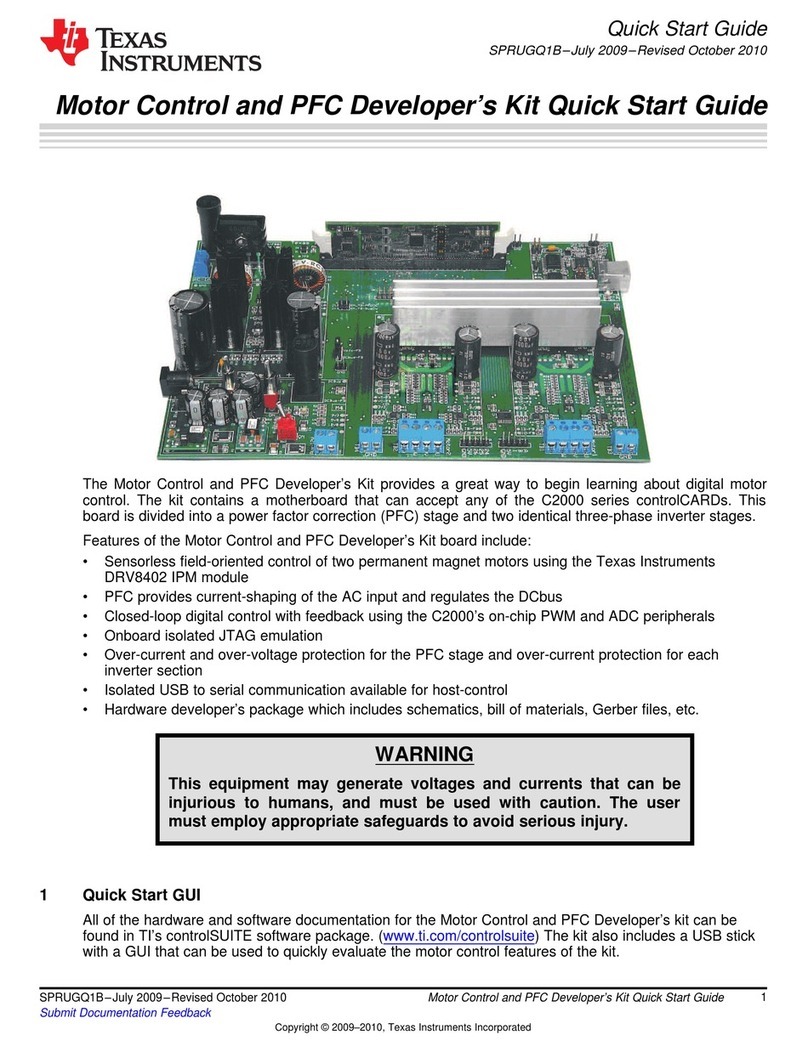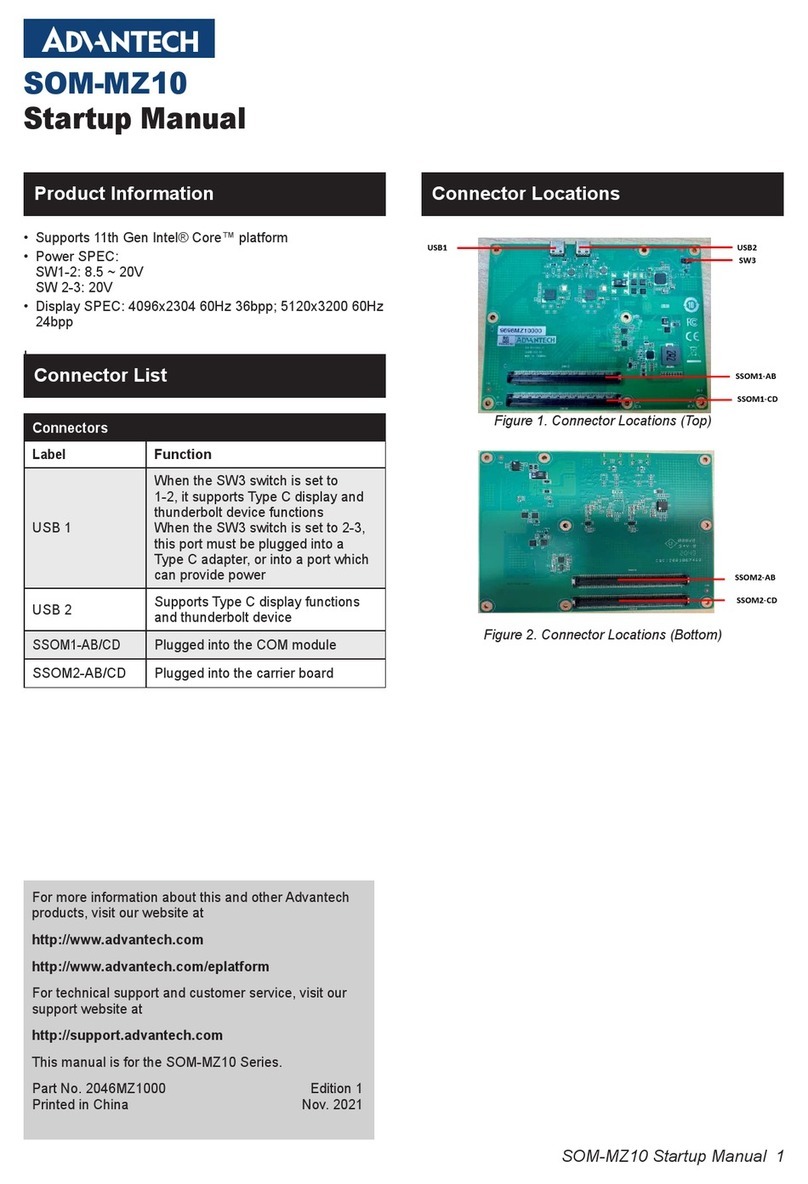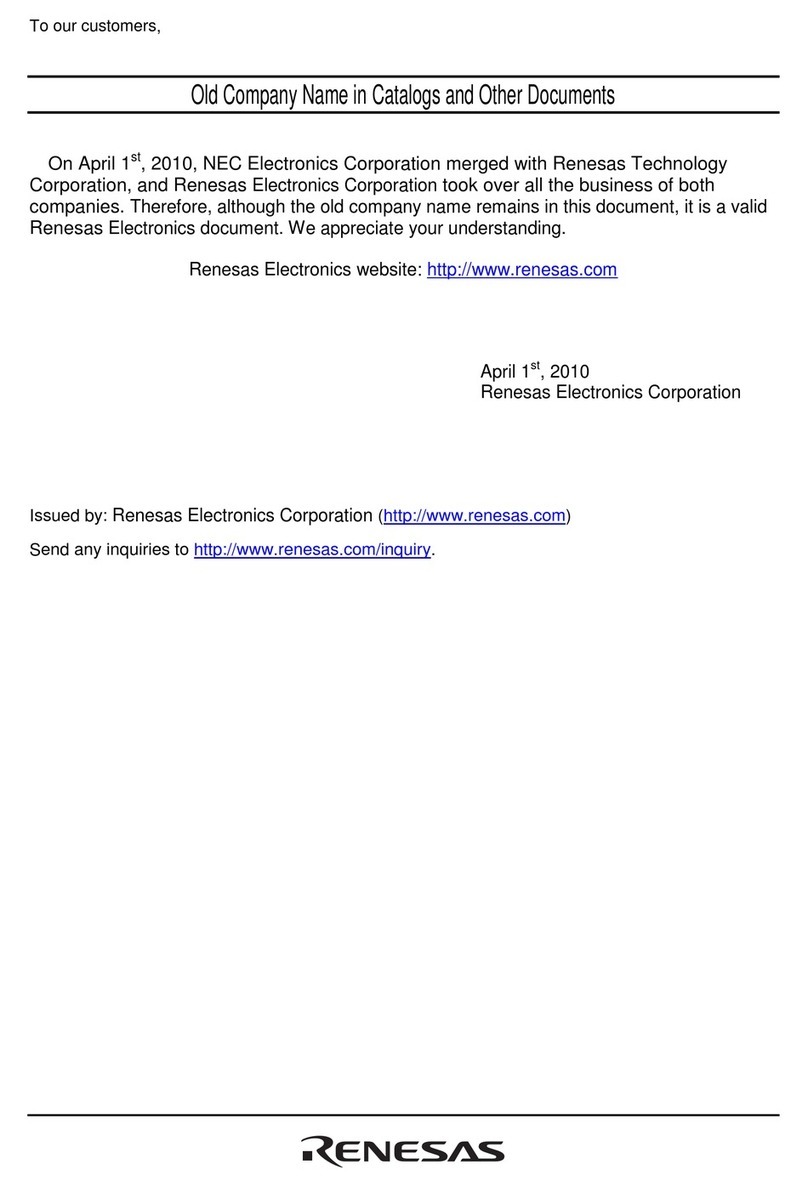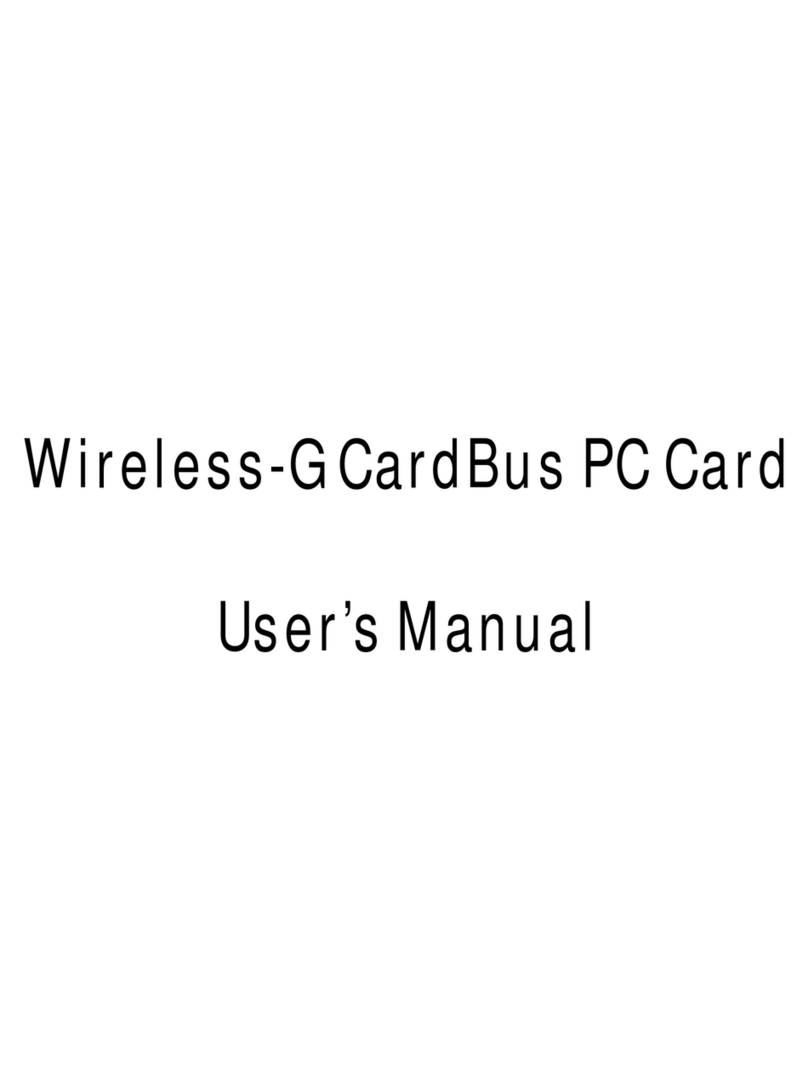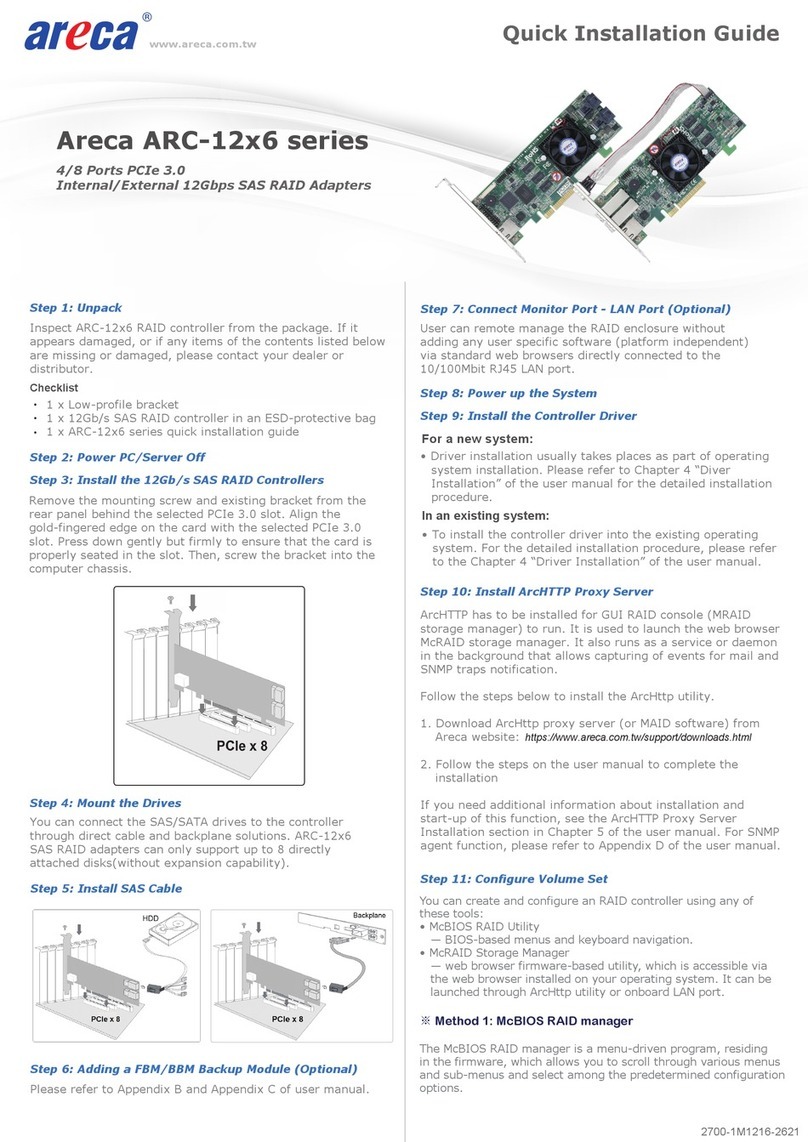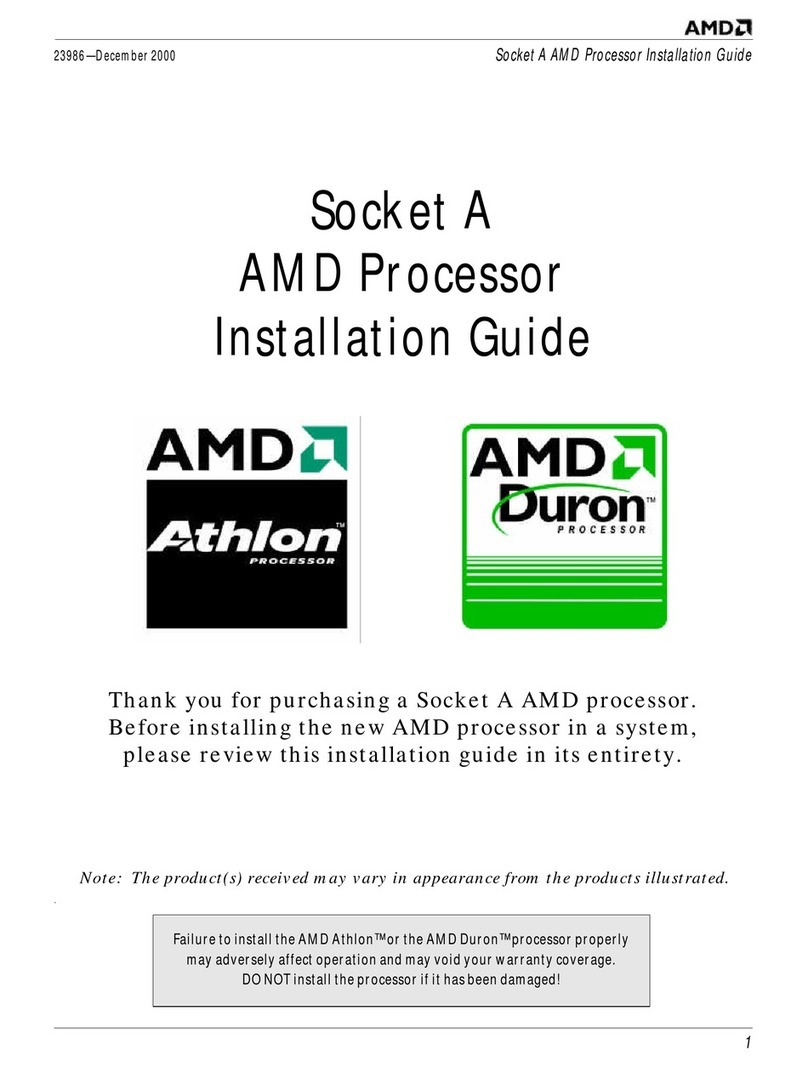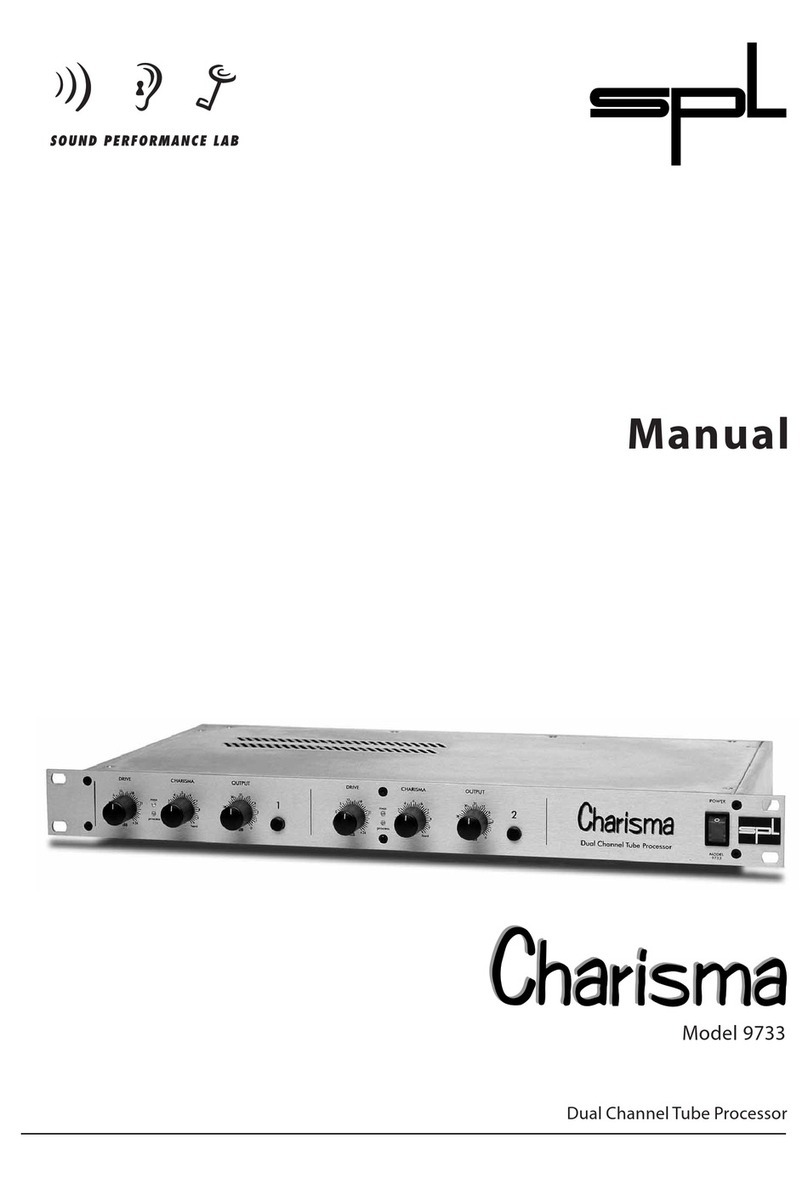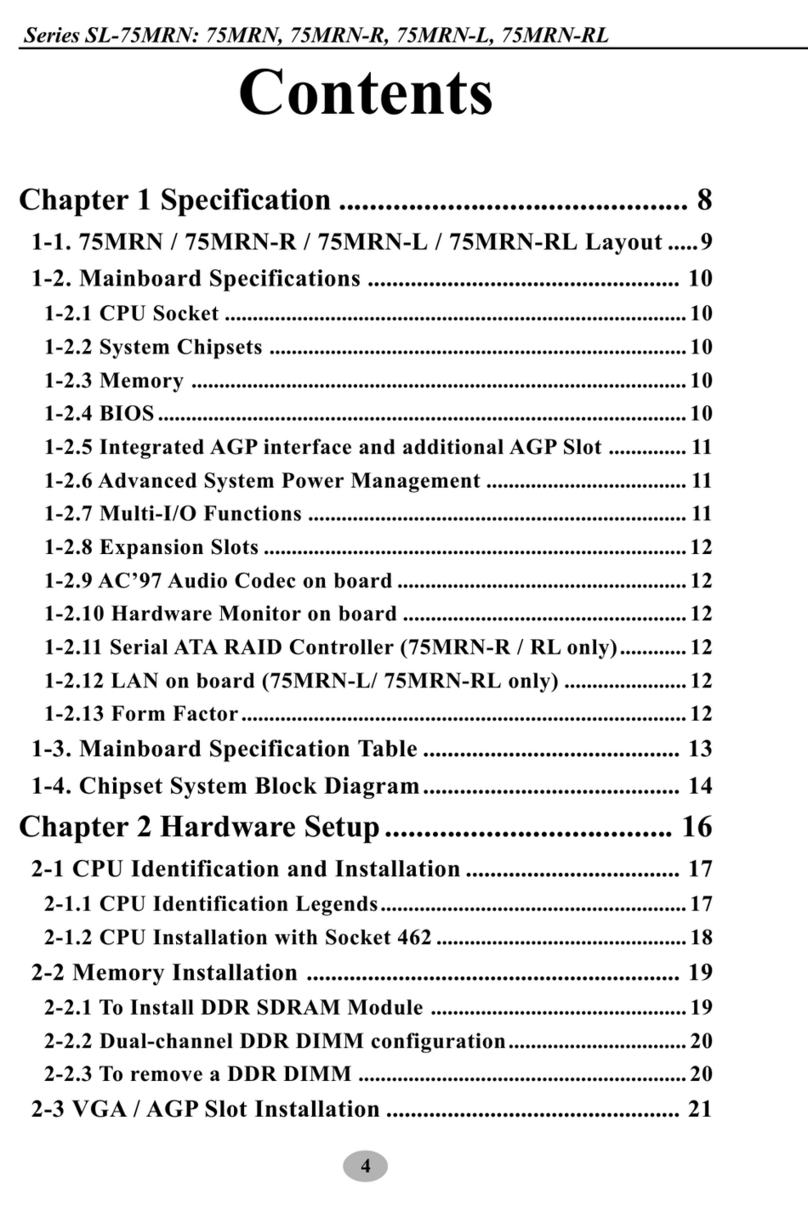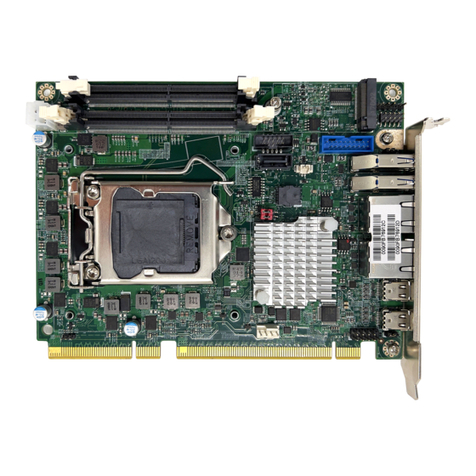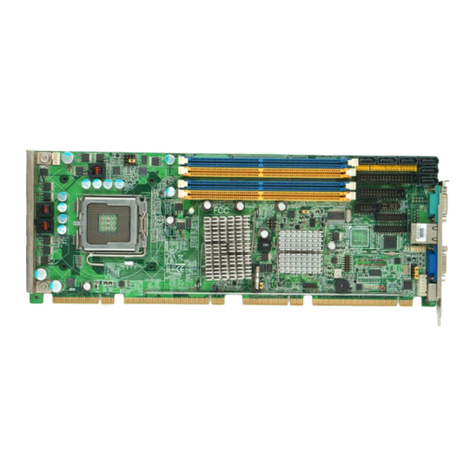BlueChip ATOM User manual

ATOM
Half Length Multimedia PC
User Manual


ATOM
User Manual
Document Part N°01271029.doc
Document Reference ATOM\docs\01271029.doc
Document Issue Level 2.0
Manual covers PCBs with the following Issue 2.x (x is any alpha/digit)
All rights reserved. No part of this publication may be reproduced, stored in any retrieval system, or transmitted, in any form or by any means,
electronic, mechanical, photocopied, recorded or otherwise, without the prior permission, in writing, from the publisher. For permission in the
UK contact Blue Chip Technology.
Information offered in this manual is believed to be correct at the time of printing. Blue Chip Technology accepts no responsibility for any
inaccuracies. The information contained herein is subject to change without notice. There are no express or implied licences granted herein to
any intellectual property rights of Blue Chip Technology Ltd.
All trademarks and registered names acknowledged.
Blue Chip Technology Ltd.,
Chowley Oak, Tattenhall,
Chester, Cheshire,
CH3 9EX
Telephone : 01829 772000 Facsimile : 01829 772001
www.bluechiptechnology.co.uk

Amendment History
Issue
Level Issue
Date Author Amendment Details
1.0 04/11/98 TGH First Draft Issue
2.0 26/05/99 TGH First Issue

CONTENTS
Blue Chip Technology Ltd. 01271029.doc
COMPANY PROFILE ..................................................................................................................................1
INTRODUCTION..........................................................................................................................................1
MANUAL OBJECTIVES ................................................................................................................................1
LIMITATIONS OF LIABILITY......................................................................................................................1
PRECAUTIONS..............................................................................................................................................1
ELECTRO-STATIC DISCHARGES ..............................................................................................................1
ON-BOARD BATTERY.................................................................................................................................1
RELATED PUBLICATIONS...........................................................................................................................2
TRADEMARKS..............................................................................................................................................2
USER GUIDE.................................................................................................................................................3
OVERVIEW....................................................................................................................................................3
BOARD LEVEL FEATURES........................................................................................................................3
CPU.............................................................................................................................................................4
PROCESSOR SOCKET................................................................................................................................4
SECOND LEVEL CACHE............................................................................................................................4
SYSTEM MEMORY......................................................................................................................................4
BUS EXPANSION SLOTS ............................................................................................................................5
ELECTROMAGNETIC COMPATIBILITY....................................................................................................5
SPECIFICATION............................................................................................................................................5
HARDWARE DESCRIPTION......................................................................................................................7
CHIPSET.........................................................................................................................................................7
82439HX XCELERATED CONTROLLER (TXC)..........................................................................................7
PCI/ISA IDE XCELERATOR (PIIX3).............................................................................................................7
UNIVERSAL SERIAL BUS (USB)..................................................................................................................8
I/O CONTROLLER.........................................................................................................................................8
IDE SUPPORT.............................................................................................................................................8
SMC 37C932 SUPER I/O CONTROLLER ......................................................................................................9
FLOPPY CONTROLLER..............................................................................................................................9
KEYBOARD/MOUSE INTERFACE..............................................................................................................9
REAL TIME CLOCK, CMOS RAM AND BATTERY................................................................................... 10
ATOM IS YEAR 2000 COMPLIANT...........................................................................................................10
CHIPS & TECHNOLOGY GRAPHICS SUBSYSTEM.................................................................................. 10
DISPLAY CAPABILITIES .......................................................................................................................... 10
BIOS..............................................................................................................................................................10
SYSTEM SETUP UTILITY.......................................................................................................................... 11
CONNECTING AN LCD TO ATOM............................................................................................................11
BACK PANEL CONNECTORS...................................................................................................................11
ON-BOARD CONNECTORS......................................................................................................................11
UTILITY CONNECTOR ......................................................................................................................... 11
SPEAKER ..............................................................................................................................................11
RESET ...................................................................................................................................................11
IDE LED................................................................................................................................................ 11
BUS CONNECTORS.................................................................................................................................. 11
JUMPERS...................................................................................................................................................... 12
CMOS BATTERY SOURCE (CLEAR CMOS) J1.........................................................................................12
SPEED SELECTION JUMPERS JP6 ......................................................................................................... 12
PANEL POWER SUPPLY J21.................................................................................................................... 12
USER-INSTALLABLE UPGRADES.............................................................................................................12
SYSTEM MEMORY....................................................................................................................................12
EDO DRAM...........................................................................................................................................13

CONTENTS
01271029.doc Blue Chip Technology Ltd.
REAL TIME CLOCK BATTERY REPLACEMENT......................................................................................13
GRAPHICS MEMORY UPGRADE.............................................................................................................13
SOLID STATE DISK SUPPORT................................................................................................................... 13
ADDRESS MAPS.......................................................................................................................................... 13
MEMORY MAP.......................................................................................................................................... 13
I/O MAP .................................................................................................................................................... 14
PCI CONFIGURATION SPACE MAP........................................................................................................ 14
INTERRUPTS & DMA CHANNELS........................................................................................................... 16
CONNECTORS............................................................................................................................................. 17
ATOM PISA............................................................................................................................................... 17
SOLID STATE DISK (SSD) ORIENTATION...............................................................................................17
ATOM ISA ................................................................................................................................................. 18
BACK PANEL CONNECTORS...................................................................................................................18
VIDEO CONNECTOR P18 (15 WAY CONDENSED D-TYPE)................................................................18
PS/2 KEYBOARD PORT P19 (6 WAY MINI-DIN) ..................................................................................18
RS232 SERIAL PORT 1 P20 (9 WAY D-TYPE)....................................................................................... 18
ETHERNET UTP CONNECTOR P25 (8 WAY RJ45 )............................................................................. 19
NTERNAL I/O HEADERS & CONNECTORS.............................................................................................19
PRIMARY E-IDE CONNECTOR P13 (2X20 WAY HEADER).................................................................19
ECP/EPP PARALLEL PORT JP1 (2X13 WAY HEADER)....................................................................... 19
PS/2 MOUSE PORT JP2 (5 WAY HEADER)..........................................................................................20
RS232 SERIAL PORT 2 P21 (2X5 WAY HEADER)................................................................................. 20
DUAL USB PORTS JP3 (2X5 WAY HEADER).......................................................................................20
LCD PRIMARY CONNECTOR P11 (2X25 WAY 2MM HEADER) ..........................................................20
LCD SECONDARY CONNECTOR FOR 36 BIT PANELS P24 (2X10 WAY 2MM HEADER) ..................21
DIGITAL VIDEO OPTION P23 (2X20 WAY 2MM HEADER)................................................................. 21
CD-AUDIO INPUT P7 (4 WAY BOX SOCKET)......................................................................................21
AUDIO CONNECTOR P8 (2X5 WAY 2MM BOX SOCKET)................................................................... 21
FLOPPY DISK DRIVE CONNECTOR P12 (2X17 WAY HEADER)......................................................... 22
RS485 SERIAL PORT 2 P14 (2X5 WAY HEADER)................................................................................. 22
IRDA CONNECTOR JP5 (5 WAY HEADER) .........................................................................................22
BATTERY CONNECTOR P1 (4 WAY HEADER) .................................................................................... 22
FAN POWER CONNECTOR J19 (2 WAY HEADER).............................................................................. 22
LCD VEE INTERFACE CONNECTOR JP4 (5 WAY HEADER).............................................................. 23
POWER CONNECTOR J20 (4 WAY)......................................................................................................23
UTILITY CONNECTOR P16 (2X10 WAY HEADER) ............................................................................. 23
COAST CACHE CONNECTOR P3......................................................................................................... 23
SPEED SETTING JP6............................................................................................................................23
CMOS CLEAR J1................................................................................................................................... 24
PANEL SUPPLY J21.............................................................................................................................. 24
PINOUT OF ISA, PISA AND PCI CONNECTORS .....................................................................................25
ERROR MESSAGES..................................................................................................................................... 27
ERROR BEEP CODES...............................................................................................................................27

COMPANY PROFILE
Blue Chip Technology Ltd. 01271029.doc
COMPANY PROFILE
Blue Chip Technology is a leading specialist PC product manufacturer in Europe.
Blue Chip Technology provides innovation with quality design and manufacturing from a single source.
Based in the North West of England, our purpose built complex contains both advanced research and
development facilities, and manufacturing facilities.
Specialising in the provision of industrial computing and electronic solutions for a wide range of UK and
European organisations, Blue Chip Technology has one of the UK's largest portfolios of industrial PCs,
peripherals and data acquisition cards. This extensive range of products, coupled with our experience and
expertise, enables Blue Chip Technology to offer an industrial processing solution for any application. The
ATOM Single Board PC is the latest addition to our portfolio, providing a cost effective product
development and volume production tool for OEMs.
A unique customisation and specialised system integration service is also available, delivering innovative
solutions to customers problems. The company's success and reputation in this area has led to a number of
large design and manufacturing projects for companies such as GEC Marconi, Aston Martin, Shell and
British Gas.
British Standards Institute approval (BS EN 9001) means that all of Blue Chip Technology's design and
manufacturing procedures are strictly controlled, ensuring the highest levels of quality, reliability and
performance.
Blue Chip Technology are also committed to the single European market and continue to invest in the latest
technology and skills to provide high performance computer and electronic solutions for a world-wide
customer base.


ATOM USER MANUAL INTRODUCTION PAGE 1
BLUE CHIP TECHNOLOGY LTD.01271029.DOC PAGE 1
INTRODUCTION
MANUAL OBJECTIVES
This manual describes in detail the Blue Chip Technology ATOM Single Board processor card.
We have tried to include as much information as possible but we have not duplicated information that is
provided in the standard IBM Technical References, unless it proved to be necessary to aid in the
understanding of the ATOM.
The manual is sectioned and includes a User Guide which will help the non technical user to get the unit up
and running. A Troubleshooting Guide is also included to help when things go wrong.
We strongly recommend that you study this manual carefully before attempting to interface with ATOM or
change the standard configurations. Whilst all the necessary information is available in this manual we
would recommend that unless you are confident, you contact your supplier for guidance.
Please be aware that it is possible to create configurations within the CMOS RAM that make booting
impossible. If this should happen, clear the CMOS settings, (see the description of the Jumper Settings for
details).
If you have any suggestions or find any errors concerning this manual and want to inform us of these, please
contact our Technical Services department with the relevant details.
LIMITATIONS OF LIABILITY
In no event shall Blue Chip Technology be held liable for any loss, expenses or damages of any kind
whatsoever, whether direct, indirect, incidental or consequential, arising from the design or use of this
product or the support materials supplied with this product. If this product proves to be defective, Blue Chip
Technology is only obliged to replace or refund the purchase price at Blue Chip Technology's discretion
according to their Terms and Conditions of Sale.
PRECAUTIONS
It is imperative that precautions are taken to avoid electro-static discharges, or any maltreatment of the on-
board battery.
ELECTRO-STATIC DISCHARGES
The devices on this card can be totally destroyed by static electricity. Ensure that you take necessary static
precautions, ideally wear an approved wrist strap or touch a suitable ground to discharge any static build
up. This should be repeated if the handling is for any length of time.
When carrying the board around, please place it into the anti-static bag in which it came. This will prevent
any static electricity build up.
ON-BOARD BATTERY
This board is fitted with a Lithium battery. Great care should be taken with this type of battery. Under NO
circumstances should :
• the outputs be shorted
• be exposed to temperatures in excess of 100°C
• be burnt
• be immersed in water

PAGE 2INTRODUCTION ATOM USER MANUAL
PAGE 201271029.DOC BLUE CHIP TECHNOLOGY LTD.
• be unsoldered
• be recharged
• be disassembled
If the battery is mistreated in any way there is a very real possibility of fire, explosion, and harm.
RELATED PUBLICATIONS
The following publications will provide useful information related to the Standard Personal Computer and
can be used in conjunction with this manual.
• IBM Personal Computer AT Technical Reference, 1502494, IBM, 1984.
• IBM Personal System/2 and Personal Computer BIOS Interface Technical Reference, 15F0306, IBM,
1987.
• The Programmers PC Sourcebook, Microsoft
• The Winn L. Rosch Hardware Bible, Brady
TRADEMARKS
IBM, PC, AT and PS/2 are trademarks of International Business Machines Corporation (IBM).
Phoenix Pico BIOS is a trademark of Phoenix Inc
Intel is a registered trademark of the Intel Corporation.
All 80x86 and Pentium processors are registered trademarks of Intel Corporation.
K6, K6-2 and 3D-Now! are trademarks of AMD.
C6 and Win Chip are trademarks of IDT.
MSDOS and WINDOWS are registered trademarks of the Microsoft Corporation.

ATOM USER MANUAL USER GUIDE PAGE 3
BLUE CHIP TECHNOLOGY LTD.01271029.DOC PAGE 3
USER GUIDE
OVERVIEW
The Blue Chip Technology ATOM single board PC sets new standards for integration of the latest advances
in processor, memory, and I/O technologies. The ATOM PISA complies with the new PISA standard
providing ISA and PCI bus interfaces on a single card. This half card multimedia PC is an ideal platform for
the increasing requirements of today's and tomorrow's embedded applications. The ATOM ISA provides
continued support for legacy ISA backplanes.
The flexible design will accept processors operating at 100, 133, 166, 200, 233, 266 and 300MHz, including
MMX devices. The user may install 256 KB of asynchronous Cache, or 256 KB or 512 KB of Pipeline Burst
Cache RAM in the form of a COAST (Cache On A STick) Module. The memory sub-system is designed to
support up to 256MB of EDO DRAM (for improved performance) or standard Fast Page DRAM in standard
72-pin SIMM sockets. A screwdriver activated SPGA socket accommodates the CPU.
The ATOM single board PC utilises Intel’s Triton 82430HX PCIset to provide increased integration and
performance over other single board PC designs. The Triton PCIset contains an integrated PCI Bus
Mastering IDE controller with a high performance IDE interface allowing up to two IDE devices (such as
hard drives, CD-ROM readers, etc.). The SMC 37C932 Super I/O controller integrates the standard PC I/O
functions: floppy interface, two FIFO serial ports, one EPP/ECP capable parallel port, a Real Time Clock,
keyboard and mouse (PS/2) controller.
The ATOM also provides for driving up to twenty external ISA (and four PCI expansion slots - PISA version
only).
In addition to superior hardware capabilities, a full set of software drivers and utilities are available to allow
advanced operating systems such as Windows™ 95 to take full advantage of the hardware capabilities.
Features such as bus mastering IDE, Windows™ 95/98 ready Plug and Play, Advanced Power Management
(APM) are available for the ATOM.
BOARD LEVEL FEATURES
• SPGA socket supporting 75 - 300 MHz operation
• On-board 3.3 V CPU voltage regulator
• Intel Triton 82430 PCIset chipset:
82439HX Xcelerated Controller (TXC)
PIIX3 PCI ISA IDE Accelerator (PIIX3) bridge
• 256KB or 512 KB PipeLine Burst Level 2 cache or 256 KB Asynchronous Level 2 cache using
plug-in COAST connector
• Two SIMM sockets providing up to 256MByte of EDO or FPM DRAM
• C&T 69000 PCI CRT/LCD graphics controller with:
2 MByte video memory
• PCI and ISA expansion busses via a PISA connector or ISA only via ISA connector
• SMC 37C932 I/O controller providing:
Dual PCI IDE interfaces
Dual floppy interface
EPP/ECP bi-directional parallel interface
• PCI 100/10 base-T Ethernet controller
• Dual USB ports
• Stereo sound (Soundblaster™ compatible )

PAGE 4USER GUIDE ATOM USER MANUAL
PAGE 401271029.DOC BLUE CHIP TECHNOLOGY LTD.
• Dual RS232 serial ports. RS422/485/IRDA port. option on the second serial port.
• Real-time clock with on-board battery
• PS/2 mouse and keyboard connectors
• Plug-in M-Systems Flash modules up to 72MB capacity.
• Drive for up to 20 ISA and 4 PCI cards (PISA version)
CPU
The ATOM single board PC is designed to operate with Pentium-class Processors running at 2.2, 2.8, 2.9
or 3.3 Volts. An on-board voltage regulator circuit provides the required voltage for the processor from the
incoming 5 volt power supply.
The Pentium processor maintains full backward compatibility with the 8086, 80286, i386and Intel486
processors. It supports both read and write burst mode bus cycles, and includes separate on-chip code and
data caches which employ a write-back policy. Also integrated into the Pentium processor is an advanced
numeric co-processor which significantly increases the speed of floating point operations, whilst
maintaining backward compatibility with Intel486math co-processor and complying to ANSI/IEEE
standard 754-1985.
PROCESSOR SOCKET
The ATOM single board PC has a 321-pin SPGA socket. Processor replacement requires the careful use of
a flat blade screwdriver. A heatsink and fan will be required for many of the processors. These will make
CPU fitting difficult because of their placement, especially if they reduce the mechanical advantage of the
screwdriver. The screwdriver can be cranked to overcome this by putting a bend in it at the point it
contacts the edge of the CPU. 3.5mm screwdrivers have been found to be ideal.
Insert the CPU carefully observing the missing pin of the polarisation corner (inspect the pins for
alignment first). Place the screwdriver all the way into the special aperture in the socket between CPU and
large capacitors. Using only the flat of the blade against the CPU, lever the CPU away from the capacitors
until a sharp click indicates proper location. Check that the CPU now sits as far towards the memory end
of the socket as possible. The edge should rest against the plastic by the extraction screwdriver aperture.
Removal is an identical operation using the aperture on the memory side and levering towards the
capacitors, followed by easy lifting out of the socket.
SECOND LEVEL CACHE
A second level cache using the COAST connector can complement the Pentium processor’s internal cache.
Pipeline Burst SRAM provides performance similar to expensive Synchronous Burst SRAMs for only a
slight cost premium over the slower performing Asynchronous SRAMs. With the Triton chipset, the
performance level of Pipeline Burst and Synchronous SRAMs is identical.
SYSTEM MEMORY
The ATOM single board PC provides two 72-pin SIMM sites for memory expansion. The sockets support
1M x 32 (4 MB), 2M x 32 (8 MB), 4M x 32 (16 MB), 8M x 32 (32 MB), 16M x 32 (64 MB) and 32MB x
32 (128 MB) single-sided or double-sided SIMM modules. Minimum memory size is 8 MB and
maximum memory size, using two 32MB x 32 SIMM modules, is 256 MB. Memory timing requires 70 ns
fast page devices or, for optimum performance, 60nS EDO DRAM. If the memory bus speed is 60 MHz or
slower (75MHz, 90MHz, 120MHz, 150MHz or 180MHz Pentium Processor speed), 70ns EDO DRAM
may be used. If the memory bus speed is 66 MHz, 60 ns DRAM should be used. Additionally, 36-bit
SIMM modules may be used to provide either standard parity operation or the parity circuitry can be used
by the HX chipset to provide ECC correction. EDO DRAM is designed to improve DRAM read
performance. Both sockets must be occupied with identical SIMM types as the two sockets are arranged in
a bank which provides a 64-bit wide data path. There are no jumper settings required for the memory size
or type, this is automatically detected by the system BIOS.

ATOM USER MANUAL USER GUIDE PAGE 5
BLUE CHIP TECHNOLOGY LTD.01271029.DOC PAGE 5
BUS EXPANSION SLOTS
The ATOM is designed for use in an embedded application and provides expansion via PISA or ISA edge
connectors. The PISA version can plug into a suitable backplane to drive up to 20 ISA bus expansion cards
and 4 PCI expansion cards. The ISA version can drive up to 20 ISA bus expansion cards.
ELECTROMAGNETIC COMPATIBILITY
This product meets the requirements of the European EMC Directive (89/336/EEC) and is eligible to bear
the CE mark.
ATOM has been assessed operating in a Blue Chip Technology PC. However, because the board can be
installed in a variety of computers, certain conditions have to be applied to ensure that the compatibility is
maintained. Subject to those conditions, it meets the requirements for an industrial environment (Class A
product).
• The board must be installed in a computer system chassis which provides screening suitable for an
industrial environment.
• Any recommendations made by the computer system manufacturer/supplier must be complied with
regarding earthing and the installation of boards.
• The board must be installed with the optional back plate securely screwed to the chassis of the
computer to ensure good metal-to-metal (i.e. earth) contact.
• Most EMC problems are caused by the external cabling to boards. It is imperative that any external
cabling to the board is totally screened, and that the screen of the cable connects to the metal end
bracket of the board and hence to earth. It is recommended that round screened cables with a braided
wire screen are used in preference to those with a foil screen and drain wire. Use metal connector
shells which connect around the full circumference of the screen: they are far superior to those which
earth the screen by a simple “pig-tail”.
• The keyboard and mouse will play an important part in the compatibility of the processor card since
they are ports into the board. Similarly, they will affect the compatibility of the complete system. Fully
compatible peripherals must be used otherwise the complete system could be degraded. They may
radiate or behave as if keys/buttons are pressed when subject to interference. Under these
circumstances it may be beneficial to add a ferrite clamp on the leads as close as possible to the
connector. A suitable type is the Chomerics type H8FE-1004-AS.
• Ensure that the screens of any external cables are bonded to a good RF earth at the remote end of the
cable.
Failure to observe these recommendations may invalidate the EMC compliance.
Warning
This is a Class A product. In a domestic environment this product may cause radio
interference in which case the user may be required to take adequate measures.
SPECIFICATION
ATOM Power +5 V ± 5% Required for processor operation.
Requirement +12 V ± 5% Required for Network /Audio.
+3.3 V ± 5% Not required for board operation.
-5 V ± 5% The ISA, & PCI voltage
-12 V ± 5% rails are linked on board.

PAGE 6USER GUIDE ATOM USER MANUAL
PAGE 601271029.DOC BLUE CHIP TECHNOLOGY LTD.
Typical System
Consumption 3.5A 5V K6-2/300, 16 MB RAM, 256 KB
0.15A 12V cache
2.0A 5V C6 200, 32MB RAM, 256KB cache
0.15A 12V IDT C6MP200 3.3V 66MHz bus.
Temperature Non-Operating -40°C to +70°C
Operating +0°C to +55°C
(min. airflow of 200 lpm)
Shock Non-Operating Half sine, 2ms, 1 m drop
Vibration Non-Operating 5 Hz - 500 Hz, 3.1 g RMS random
Operating 10 Hz - 500 Hz, 1.0 g RMS random
EMC Emissions EN55022 (A)
Immunity EN50082-2 in a Blue Chip ICON Industrial PC Chassis
MTBF Calculated >100,000 Hrs
Dimensions Board only 338 x 122 mm
Power Consumption figures given are for typical configurations.
This information is preliminary and is provided only as a guide to calculating approximate total system
power usage when additional resources are added.

CHIPSET
The Intel 82430HX PCIset consists of the 82439HX Xcelerated Controller (TXC) and one 82371SB
PCI/ISA IDE Xcelerator (PIIX3) bridge chip.
82439HX XCELERATED CONTROLLER (TXC)
The 82439HX provides all control signals necessary to drive a second level cache and the DRAM array,
including multiplexed address signals. The TXC also controls access to memory and generates snoop
controls to maintain cache coherency. The TXC comes in a 324-pin BGA package and includes the
following features:
• Microprocessor interface control
• Integrated L2 write-back cache controller
Pipeline burst SRAM
256 KB direct-mapped
• Integrated DRAM controller
64 bit path to memory
Support for EDO and fast page DRAM
Parity and non-parity support
• Fully synchronous PCI bus interface
25/30/33 MHz bus speed
PCI to DRAM > 100 MB/sec
Up to four PCI masters in addition to the PIIX3
PCI/ISA IDE XCELERATOR (PIIX3)
The PIIX3 provides the interface between the on-board PCI and ISA buses and integrates a dual channel
fast IDE interface capable of supporting two devices. The PIIX3 integrates seven DMA channels, one 16-
bit timer/counter, two eight-channel interrupt controllers, PCI-to-AT interrupt mapping circuitry, NMI
logic, ISA refresh address generation, and PCI/ISA bus arbitration circuitry together onto the same device.
The PIIX3 comes in a 208-pin QFP package and includes the following features.
• Interface between the PCI and ISA buses
• Universal Serial Bus controller
Host/hub controller

Integrated 8 x 32-bit buffer for bus master PCI IDE burst transfers
Bus master mode
• PCI 2.1 compliant
• Enhanced fast DMA controller
• Interrupt controller and steering
• Counters/timers
• SMI interrupt logic and timer with fast on/off mode
UNIVERSAL SERIAL BUS (USB)
The ATOM single board PC features two USB ports available via cable set. The ports permit the direct
connection of two USB peripherals without an external hub. If more devices are required, an external hub
can be connected to either of the built-in ports. ATOM fully supports the standard universal host controller
interface (UHCI) and uses standard software drivers that are UHCI-compatible. Features of the USB
include:
• Self-identifying “hot pluggable” peripherals
• Automatic mapping of function to driver and configuration
• Support for isochronous and asynchronous transfer types over the same set of wires
• Support for up to 127 physical devices
• Guaranteed bandwidth and low latencies appropriate for telephony, audio, and other applications
• Error handling and fault recovery mechanisms built into protocol
NOTE
Computer systems that have an unshielded cable attached to the USB port might not meet FCC Class B
requirements, even if no device or a low speed (sub-channel) USB device is attached to the cable. Use
shielded cable that meets the requirements for high speed (fully rated) devices.
I/O CONTROLLER
IDE SUPPORT
The ATOM single board PC provides one high performance bus-mastering PCI IDE interface capable of
supporting PIO Mode 3 and Mode 4 devices. The system BIOS supports Logical Block Addressing (LBA)
and Extended Cylinder Head Sector (ECHS) translation modes as well as AT API (e.g. CD-ROM) devices
on the IDE interface. Detection of IDE device transfer rate and translation mode capability is
automatically determined by the system BIOS.

Microsoft will provide this driver for Windows™ 95/98, other software vendors may make drivers
available for other operating systems.
Detailed information on the PCIset is available in the Intel 82430 PCIset data sheet.
SMC 37C932 SUPER I/O CONTROLLER
Control for the integrated serial ports, parallel port, floppy drive, RTC and keyboard controller is
incorporated into a single component, the SMC 37C932. This component provides:
•Two powered NS16C550-compatible UARTs with send/receive 16 byte FIFO
•Multi-mode bi-directional parallel port
- Standard mode; IBM and Centronics compatible
- Enhanced Parallel Port (EPP) with BIOS/Driver support
- High Speed mode; Extended Capabilities Port (ECP) compatible
•Industry standard floppy controller with 16 byte data FIFO (2.88 MB floppy support)
•Integrated Real Time Clock
•Integrated 8042 compatible keyboard/mouse controller
The 37C932 is normally configured by the BIOS automatically, however configuration of these interfaces is
possible via the CMOS set-up program that can be invoked during boot-up. The serial ports can be enabled
as various standard COM ports, or disabled. The parallel port can be configured as normal, bi-directional,
EPP/ECP, or disabled. The floppy interface is also configurable.
Header connectors located near the top of the board allow cabling to use these interfaces. Take care to
observe the polarity of the headers. Pin 1 is placed at the metal bracket end of the board on all the open
headers.
FLOPPY CONTROLLER
The 37C932 is software compatible with the DP8473 and 82077 floppy disk controllers.
The floppy interface can be configured for 360 KB or 1.2 MB 5¼" media or for 720 KB, 1.44 MB, or 2.88
MB 3½" media in the BIOS set-up. By default, the Floppy A interface is configured for 1.44 MB and
Floppy B is disabled.
KEYBOARD/MOUSE INTERFACE
A PS/2 keyboard/mouse connector is located on the back panel side of the single board PC. A splitter cable
allows mouse and keyboard connection, else only the keyboard occupies this connector. The mouse
interface is also available through a polarised header. A Polyswitch resetable fuse protects the 5V lines to
these connectors. Care must be taken to turn off the system power before installing or removing a keyboard
or mouse, otherwise the fuse may trip. The Polyswitch will reset itself once the fault condition is cleared
and the power to the circuit is removed, allowing it to cool.
The integrated 8042 microcontroller contains the AMI Megakey keyboard/mouse controller code which,
besides providing traditional keyboard and mouse control functions, supports Power-On/Reset (POR)
password protection. The POR password can be defined by the user in the Setup program. The keyboard
controller also provides the facility for a <CTRL><ALT><DEL> "hot key" sequence to perform a system

RTC also supports 242 bytes of battery-backed CMOS RAM in two banks which is reserved for BIOS use.
The CMOS RAM can be set to specific values or cleared to the system default values using the BIOS SET-
UP program. Also, the CMOS RAM values can be cleared to the system defaults by using a configuration
jumper on the single board PC. The appendix lists the jumper configurations.
An on-board Lithium battery provides power to the RTC and CMOS memory. The battery has an
estimated lifetime of three years if the board remains unpowered. When the system is powered up, power
is drawn from the power supply to extend the life of the battery.
ATOM IS YEAR 2000 COMPLIANT
CHIPS & TECHNOLOGY GRAPHICS SUBSYSTEM
The ATOM single board PC is provided with the very latest C&T 69000 graphics controller with 2 MB of
graphics memory. Both CRT and LCD interfaces are provided. ATOM supports a wide variety of
monochrome and colour Single-Panel, Single-Drive (SS) and Dual-Panel, Dual Drive (DD) passive STN and
active matrix TFT/MIM LCD, EL and plasma panels. ATOM supports a wide range of panel resolutions.
The 69000 has a 32-bit graphics engine that provides acceleration for scaling the video display without
compromising picture quality or frame rate. Hardware acceleration for graphics functions such as line draws,
System-to-screen and screen-to-screen BitBLTs, ROPs, which optimise performance operation under
Windows™ and other GUI environments.
Note that Chips and Technology are now a part of Intel Corporation.
DISPLAY CAPABILITIES
The 2MB of video memory can support a variety of resolutions.
The representation of each picture element (pixel) is key to working out capability.
256 colours requires 8 bits (1byte), 64K colours 16 bits (2bytes), 16M colours 24 bits (3bytes).
So 640x480x16M colours requires 640x480x3 bytes = 921600; easily fits into our 2,097,152 bytes of
memory.
The drivers supplied from C&T also need to support the desired resolution. These generally support
640x480x16M, 800x600x16M, 1024x768x64K, 1280x1024x256 and 1600x1200x256. However, 16:9 format
plasma panel and portrait mode have been provided previously.
Be aware that driving older or cheaper monitors beyond their capabilities can destroy them.
BIOS
The ATOM single board PC uses a Phoenix BIOS and a C&T Video BIOS both of which are stored in
EPROM/Flash. In addition to the System and Video BIOSes, the EPROM also contains the Setup utility,

<F2> key after the POST memory test has started and before boot begins. A prompt may be enabled that
informs users to press the <F2> key to access Setup. Deep power-down displays may not light up in time
to display this message.
See the BIOS user manual for further details.
CONNECTING AN LCD TO ATOM
Unfortunately, connecting an LCD panel to a PC is not as simple as it is for a CRT. At the time of writing
this manual there is still no universally accepted standard interface for LCDs. We strongly recommend that
if you are in any doubt about connecting a LCD panel to ATOM you contact our Technical Services team
with full details of the target display. ALWAYS check your wiring before you switch on.
CONNECTORS
A selection of connectors are available on the ATOM PC board. These provide connectivity to standard
external peripherals (monitor, keyboard, etc.), in-chassis peripherals (disk drives, etc.), and bus devices.
BACK PANEL CONNECTORS
The back panel provides external access to the CRT, keyboard/mouse, a Serial port, and Ethernet port. All
the connectors follow the industry standard (mouse access as on notebooks with Y cable).
ON-BOARD CONNECTORS
There are connectors on-board for Floppy Disk Drive, IDE, LCD 1 & 2, Digital Video, RS422/485, IrDa,
PISA or ISA, USB, Sound, CD Audio, PS/2 mouse and utilities connector. There are also sockets for
SIMMs, COAST (cache), Flash Solid State Disks, external battery and power.
UTILITY CONNECTOR
The ATOM PC board provides connectors to support functions which would normally be located within
the enclosure, and also duplicate connections for some of the external interfaces (System Speaker,
System Reset Switch, Keyboard, Power LED Hard Drive Activity LED, and an External Battery).
SPEAKER
An on-board Piezo speaker is provided. An off-board speaker may be connected to the header (P16 pins
1 & 2). The speaker provides error beep code information during the Power-On Self Test if the system
cannot recognise critical interfaces.
RESET
Two pins of header P16 (pins 3 & 4) may be connected to a momentary normally open SPST switch.
When the switch is closed, the system will perform a hard reset and run the POST.
IDE LED
Two pins of header P16 (pins 13 & 14) may be connected to an LED to provide a light when an IDE
hard drive connected to the on-board IDE controller is active.
BUS CONNECTORS

through software set-up. Some of the jumpers are factory set to suit particular semiconductor options. These
must not be disturbed, or damage to the board may ensue.
CMOS BATTERY SOURCE (CLEAR CMOS) J1
This jumper is used to clear the CMOS RAM in the event that the contents become corrupt. It selects the
source of backup power to the CMOS RAM, and also allows the CMOS to be cleared down to the default
settings.
Fitting the link to the “CLR” position with the power off, allows on-board capacitors to discharge and will
reset the CMOS memory. The jumper should then be returned to the “NORM” position to restore normal
operation.
SPEED SELECTION JUMPERS JP6
This set of jumpers is provided to set the CPU internal speed and the CPU external bus speed.
The external bus speed is always as shown in the tables in this document.
The internal CPU speed is expressed as a multiplication of this frequency.
Unfortunately the CPU manufacturers do not have any consistency of settings for particular multiplication
settings - each CPU type requires information from the data sheet! Many common, current values have
been listed in this document but other requirements can be determined by understanding the BF[2-0]
operation: inserting a jumper sets the signal to logical low (0V).
PANEL POWER SUPPLY J21
This sets the power supplied to the panel interface to 5V or 3.3V.
Table of Jumpers
JUMPER AREA OF INFLUENCE LINK ACTION
J1 CMOS Battery Support None
CLR
NORM
Not Allowed
Clear CMOS RAM
Use on-board battery
JP6 CPU and PCI bus speed plus
CPU internal speed See “
Speed Setting JP6” on page 23
J21 Panel voltage supply 3V/5V 3.3V supply
5V supply
USER-INSTALLABLE UPGRADES
SYSTEM MEMORY
The table shows the possible memory combinations. ATOM will support both Fast Page DRAM or EDO
DRAM SIMMs, but they cannot be mixed. Parity/Error Correction is supported when using parity SIMMs
(x36).
SIMM requirements are 70ns Fast Page Mode or 60nS EDO DRAM (70 ns EDO may be used with a 60
Table of contents
Other BlueChip Computer Hardware manuals

